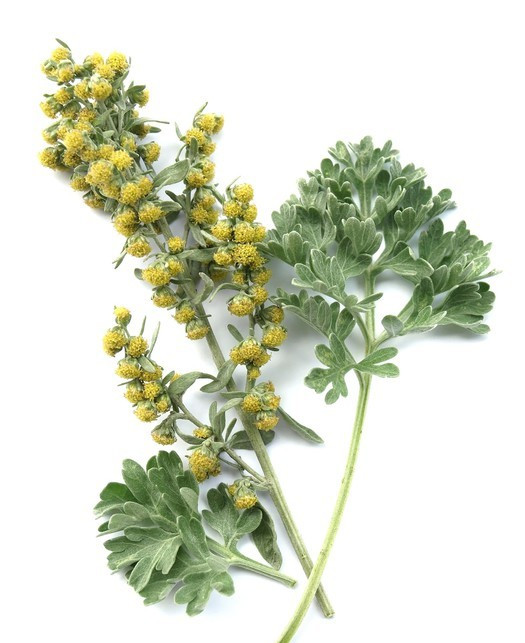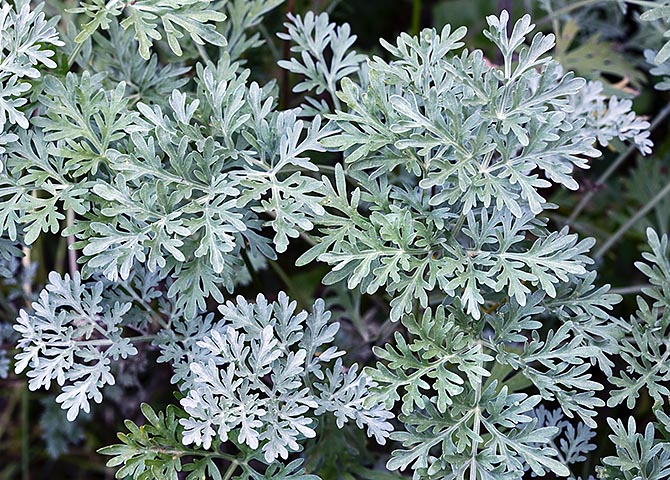Scientific name: Artemisia absinthium
Other Names: Green Ginger, Absinthe
Medicinal Parts: The medicinal parts are the aerial shoots and leaves of the plant.
Characteristics: The plant has an aromatic odour and a very bitter taste.

Leaves, Stem and Root: This semi-shrub grows from 60 to 120 cm in height with a woody, hardy rosette and a high-branch bearing stem. The stem is usually erect and leafy. The alternate, long-petioled leaves are silky pubescent on both sides. The lower leaves are abrupt pinnate and the upper ones simple. The leaf tips are lanceolate to linear-lanceolate, obtuse to acuminate and 2 to 3 mm wide.
Habitat: Wormwood grows in northern Africa, Europe, parts of Asia, and North and South America.
Constituents of the plant
Volatile oil: with a high level (varies a great deal among different strains) of (+)-thujone, cis-epoxy ocimene. trans-sabinyl acetate or chrysanthenyl acetate.
Sesquiterpene bitter principles: including absinthine, anab-sinthine, artabsine and matricine.
Medicinal Uses
The cholagogic, digestive, appetite-stimulating and wound-healing effects ascribed to this plant are attributed to the essential oils and amaroids. A significant increase of alpha-amylase, liapse, bilirubin and cholesterol has been observed during the 70 to 100 minutes during which patients with liver disorders were given a suspension of 20 mg extract in 10 ml water via a duodenal probe. In rabbits, fever induced through yeast injection was reduced by using an esophageal probe to administer diverse fractions of the herb. In vitro, a watery extract of the whole herb is supposed to retard the growth of Plasmodium falciparum. Its essential oil may possess an antimicrobial effect. It also stimulates the bitter receptors in the taste buds of the tongue. When bitter agents are introduced into the mouth, they trigger a reflexive increase of stomach secretion with higher acid concentration.
Indication and Usage
Approved by Commission E:
• Loss of appetite
• Dyspeptic complaints
• Liver and gallbladder complaints
Traditional Medicine: In folk medicine, wormwood preparations are used internally for gastric insufficiency, intestinal atonia, gastritis, stomachache, liver disorders, bloating, anaemia, irregular menstruation, intermittent fever, loss of appetite and worm infestation. Externally, it is applied for poorly healing wounds, ulcers, skin blotches and insect bites.
Dosage
Mode of Administration: Comminuted herb is used for infusions and decoctions. Powdered herb, extracts and tinctures in liquid or solid forms are used for oral administration. Combination with other bitters or aromatics is common.
Preparation: To prepare an infusion, pour 150 ml boiling water over 1/2 teaspoonful of the herb, strain after 10 minutes. A decoction is prepared by adding 1 handful of herb to 1 litre of boiling water for 5 minutes. To prepare a tea, use 1 g herb in 1 cup of water.
Daily Dose: The total daily dose is 3 to 5 g of the herb as an aqueous extract. Internal dose of the infusion is 1 cup freshly prepared tea taken 30 minutes before each meal. The tincture dosage is 10 to 30 drops in sufficient water taken 3 times daily. The liquid extract dosage is 1 to 2 ml taken 3 times daily.
Externally, a decoction is used for healing of wounds and insect bites.
Storage: Wormwood must be kept in sealed containers and protected from light.
Precautions and Adverse Reactions
General: Due to the thujone content, the internal administration of large doses can lead to vomiting, stomach and intestinal cramps, headache, dizziness and disturbances of the central nervous system. In this case continuous use is not advisable.
Drug Interactions: The thujone componant may lower the seizure threshold. Caution must be exercised when administering this herb to patients that have a predisposition to seizures. Drugs that are used to control seizures may have decreased effectiveness. Wormwood preparations should not be administered in conjunction with drugs that are known to lower the seizure threshold.
Production: Wormwood consists of the fresh or dried upper shoots and leaves, the fresh or dried basal leaves, or a mixture of the aerial plant parts from Artemisia absinthium, that is harvested during flowering season from cultivated or wild plants.
Literature
Akhmedov IS et al., (1970) Khim Prir Soedin 6:691.
Akhmedov IS et al., (Artabin, a new lactone from Artemisia absinthium). In: Khim Prid Soed 5:622. 1970.
Baumann IC et al., (1975) Z Allg Med 51 (17):784.
Beauhaire J et al, (1981) Tetrahedron Letters 22 (24):2269.
Beauhaire J, Fourrey JL, (1982) J Chem Soc Perk Trans: 861.
Del Castillo J et al., (1975) Nature 253:365.
Dermanovic S et al., (1976): 87.
Greger H, Hofer O, New unsymmetrically substituted tetrahydrofuran lignans from Artemisia absinthium. In: Tetrahedron 36(24):3551. 1980.
Greger H, (1978) Phytochemistry 17:806.
Hoffman B, Herrmann K, (1982) Z Lebensm Unters Forsch 174 (3):2II.
Kasimov Ah Z et al., (Anabsin-a new diguaianolide from Artemisia absinthium). In: Khim Prid Soed 4:495. 1979.
Kasymov SZ et al., (1979) Khim Prir Soed 5:658.
Kennedy Al et al.. Volatile oils from normal and transformed roots of Artemisia absinthium. In: PH 32:1449. 1993.
Kinloch JD, (1971) Practitioner 206:44.
Lemberkovics E et al., Some phytochemical characteristics of essential oil of Artemisia absinthium L. In: Herba hung 21(3): 197-215. 1982.
Maries RJ. Kaminski J, Arnason JT. Pazos-Sanou L, Heptinstall S, Fischer NH. Crompton CW, Kindack DG, A bioassay for inhibition of serotonin release from bovine platelets. In: JNP 55:1044-1056. 1992.
Rucker G, Manns D. Wilbert S. Peroxides as constituents of plants. 10. Homoditerpene peroxides from Artemisia-absinthium. In: PH:31(0:340. 1992.
Schneider Von G. Mielke B. (1979) Deutsch Apoth Ztg 119 (25):977.
Stahl E. Gerard D. (1983) Z Lebensm Unters Forsch 176 (1):1.
Swiatek L, Dombrowicz E. (1984) Farm Pol 40 (2):729.
Vostrowski O et al., (1981) Z NaturForsch (C) 36 (5/6):369.
Vostrowski O et al., Uber die Komponenten des atherischen Olsaus Artemisia absinthium L.. In: Z Naturforsch 36(5/6):369. 1981.
Zafar MM, Hamdard ME. Hameed A, Screening of Artemisia absinthium for antimalarial effects on Plasmodium berghei in mice: Preliminary report. In: ETH 30(2):223. 1990.
Zakirov SK et al.. (1976) Khim Prir Soedin 4:548.
Further information in:
Hansel R, Keller K, Rimpler H, Schneider G (Hrsg.), Hagers
Handbuch .der Pharmazeutischen Praxis. 5. Aufl., Bde 4-6 (Drogen): Springer Verlag Berlin, Heidelberg, New York, 1992-1994
Lewin L, Gifte und Vergiftungen. 6. Aufl.. Nachdruck, Haug Verlag, Heidelberg 1992.
Madaus G, Lehrbuch der Biologischen Arzneimittel, Bde 1-3, Nachdruck, Georg Olms Verlag Hildesheim 1979.
Roth L, Daunderer M, Kormann K, Giftpflanzen, Pflanzengifte, 4. Aufl., Ecomed Fachverlag Landsberg Lech 1993.
Schulz R, Hansel R, Rationale Phytotherapie, Springer Verlag Heidelberg 1996.
Steinegger E, Hansel R, Pharmakognosie, 5. Aufl., Springer Verlag Heidelberg 1992.
Teuscher E, Lindequist U, Biogene Gifte – Biologie, Chemie, Pharmakologie, 2. Aufl., Fischer Verlag Stuttgart 1994.
Teuscher E, Biogene Arzneimittel, 5. Aufl., Wiss. Verlagsges. Stuttgart 1997.
Teuscher E, Biogene Arzneimittel, 5. Aufl., Wiss. Verlagsges. Stuttgart 1997.
Wagner H, Wiesenauer M. Phytotherapie. Phytopharmaka undpflanzliche Homoopathika. Fischer-Verlag, Stuttgart, Jena, New York 1995.
Reference
Joerg Gruenwald, PhD
Thomas Brendler, BA Christof Jaenicke, MD etal. PDR from Herbal Medicine 2000
This article is copyrighted by Ital is Vital, 2025. Want to re-post this article? Visit our guidelines.
DISCLAIMER: THIS WEBSITE DOES NOT PROVIDE MEDICAL ADVICE
The information, including but not limited to, text, graphics, images and other material contained on this website are for informational purposes only. The purpose of this website is to promote broad consumer understanding and knowledge of various health topics. It is not intended to be a substitute for professional medical advice, diagnosis or treatment. Always seek the advice of your physician or other qualified health care provider with any questions you may have regarding a medical condition or treatment and before undertaking a new health care regimen, and never disregard professional medical advice or delay in seeking it because of something you have read on this website.
